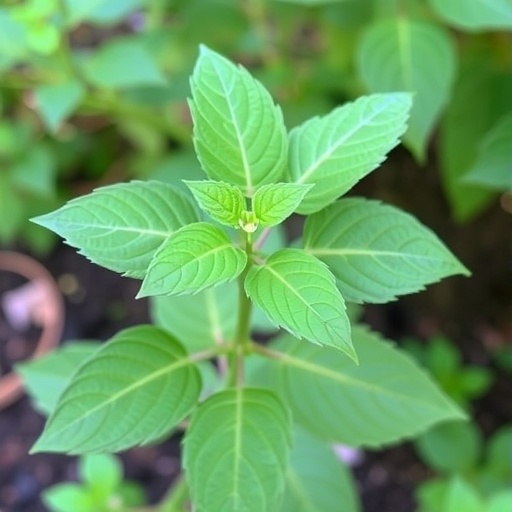In recent years, the quest for sustainable agriculture has driven researchers to explore innovative methods that minimize environmental impact while enhancing crop protection and productivity. One compelling avenue gaining traction is the use of companion planting strategies, which leverage natural plant-to-plant communication to boost resistance against pests. In an illuminating study spearheaded by Professor Gen-ichiro Arimura and his team at Tokyo University of Science, Japan, a fragrant herb known as bush basil (Ocimum species) has been demonstrated to significantly enhance pest resistance in commonly cultivated bean plants through the emission of volatile organic compounds (VOCs). This breakthrough not only offers a promising eco-friendly alternative to chemical pesticides but also unravels the intricate biochemical language plants use to defend themselves.
Professor Arimura’s team set up co-cultivation experiments where common bean plants were grown in proximity to bush basil. Analytical techniques including gas chromatography-mass spectrometry (GC-MS) allowed the researchers to identify and characterize the specific volatile compounds released by basil leaves. They discovered that among these, two major constituents, linalool and eugenol, play pivotal roles. Intriguingly, eugenol was singled out as a key compound capable of triggering enhanced defense gene expression in the beans, particularly the pathogenesis-related 1 (PR1) gene, known for its involvement in systemic acquired resistance and anti-herbivore responses.
.adsslot_dY4SAsbNcX{ width:728px !important; height:90px !important; }
@media (max-width:1199px) { .adsslot_dY4SAsbNcX{ width:468px !important; height:60px !important; } }
@media (max-width:767px) { .adsslot_dY4SAsbNcX{ width:320px !important; height:50px !important; } }
ADVERTISEMENT
The upregulation of PR1 expression in bean leaves signifies activation of intrinsic immune pathways, preparing the plant to fend off herbivorous attackers. This molecular priming was correlated with phenotypic benefits observed in pest resistance assays. By introducing two agriculturally relevant pests—the chewing herbivore Spodoptera litura and the spider mite Tetranychus urticae—into the experimental setup, the researchers assessed the practical impact of the basil’s VOC emissions. Remarkably, the co-cultivated beans exhibited a substantial reduction in egg-laying by adult female spider mites, highlighting the immediate protective effect conferred by aromatic companions.
Beyond direct pest deterrence, the study unveiled an ecological cascade benefiting crop plants. The VOCs emitted by bush basil not only bolstered the bean’s defenses but also attracted natural enemies of the pests. Specifically, the predatory mite Phytoseiulus persimilis, a known biological control agent against spider mites, was lured by the basil’s aroma. This dual mechanism—activating crop immunity while recruiting pest predators—offers a powerful, sustainable integrated pest management strategy. Such natural synergy between plants and beneficial organisms minimizes reliance on synthetic pesticides, reducing environmental contamination and health risks.
From an agronomic perspective, the research suggests practical recommendations for implementing this green technology. Planting common beans within a 100 cm radius of bush basil clusters optimizes VOC exposure and amplifies pest resistance effects without compromising crop spacing and management. This spatial parameter aligns with the diffusion range of volatile compounds in typical field conditions, providing a realistic framework for farmers and agronomists interested in ecological pest control methods.
The elucidation of the biochemical profile of bush basil’s VOCs also opens avenues for more targeted applications. While both linalool and eugenol are emitted, only eugenol demonstrated a direct role in upregulating the PR1 gene, suggesting specificity in plant responsiveness to different compounds. This insight invites future investigations into synthetic or enhanced formulations of eugenol-based treatments or the engineering of companion plants with optimized VOC emission profiles, advancing precision agriculture techniques.
The ease of cultivation and compatibility of bush basil with various crops, including soybeans and tomatoes, further underscores the adaptability of this approach. Unlike genetically modified organisms or complex chemical treatments, this strategy relies on harnessing inherent plant traits and ecological interactions, making it accessible and environmentally sound for diverse agricultural systems.
Importantly, this research bridges fundamental plant biology and applied agricultural science. It advances the understanding of how VOC-mediated signaling pathways can modulate gene expression to elicit systemic defense responses in crops, marking a step forward in bioengineering and plant-environment studies. The multidisciplinary nature of the work, encompassing plant physiology, molecular biology, ecology, and agronomy, exemplifies the holistic approach necessary for tackling food security challenges sustainably.
Funded by prestigious agencies including the Japan Society for the Promotion of Science (JSPS) and supported by Tokyo University of Science and the Ministry of Education, Culture, Sports, Science and Technology (MEXT), this research reflects Japan’s commitment to sustainable technological innovation. The findings have been published in the Journal of Agricultural and Food Chemistry, providing a scientific foundation for adopting talking plants in modern agriculture.
Looking ahead, the team envisions expanding this concept to other crop systems and companion plants, further decoding the chemical dialogues that govern plant interactions. Harnessing these natural defense potentiators offers a gateway to more resilient, environmentally compatible farming systems that balance productivity with biodiversity preservation.
In conclusion, Professor Arimura and his team’s investigation into bush basil’s VOCs has unveiled an elegant natural mechanism to potentiate plant defenses and manage pests sustainably. This research not only bridges ecological understanding with practical solutions but also shines a hopeful light on the future of agriculture—one where plants themselves become active allies in the quest for healthy, abundant harvests.
Subject of Research: Plant defense mechanisms potentiated by volatile organic compounds from companion plants
Article Title: Bush Basil Companion Plants Act as Plant Defense Potentiators for Cultivated Plants
News Publication Date: July 4, 2025
Web References: https://pubs.acs.org/doi/10.1021/acs.jafc.5c05179
References: Arimura, G.-i., et al. (2025). Bush Basil Companion Plants Act as Plant Defense Potentiators for Cultivated Plants. Journal of Agricultural and Food Chemistry. DOI: 10.1021/acs.jafc.5c05179
Image Credits: Prof. Gen-ichiro Arimura, Tokyo University of Science, Japan
Keywords
Plant sciences, Plant biotechnology, Agricultural chemistry, Agriculture, Pest control, Bioengineering
Tags: aromatic companion plants benefitsbiochemical language of plantsbush basil companion plantingchemical-free farming methodscommon bean pest resistanceeco-friendly pest managementenhancing crop resistanceinnovative agricultural researchorganic pest control strategiesplant-to-plant communicationsustainable agriculture practicesvolatile organic compounds in plants





